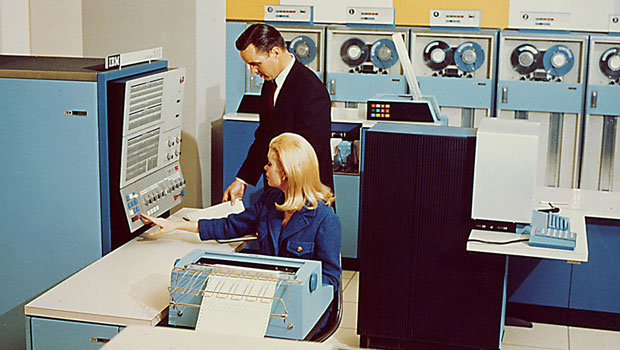
50 years ago today, IBM unveiled the System/360 mainframe, a groundbreaking computer that allowed new levels of compatibility between systems and helped NASA send astronauts to the Moon.
While IBM had been making its 700 and 7000 Series mainframes for more than a decade, the System/360 "ushered in an era of computer compatibility—for the first time, allowing machines across a product line to work with each other," IBM says. "It was the first product family that allowed business data-processing operations to grow from the smallest machine to the largest without the enormous expense of rewriting vital programs... Code written for the smallest member of the family had to be upwardly compatible with each of the family’s larger processors. Peripherals such as printers, communications devices, storage, and input-output devices had to be compatible across the family."
Before the System/360, "businesses bought a computer, wrote programs for it, and then when it got too old or slow they threw it away and started again from scratch," IBM spokesperson Barry Heptonstall told the BBC.
Text of the original press release issued by IBM's Data Processing Division on April 7, 1964 is on IBM's site. The systems would sell for $133,000 to $5.5 million, or could be rented for $2,700 to $115,000 a month. The least expensive started shipping in 1965, with higher-end ones being delivered in 1966.
Despite the high price, there was much excitement. "More than 100,000 businessmen in 165 American cities today attended meetings at which System/360 was announced," IBM said at the time. Company President Thomas J. Watson Jr. called the System/360 IBM's most important product announcement ever and said it "represents a sharp departure from concepts of the past in designing and building computers." The initial announcement didn't actually call it a "mainframe," a word IBM wouldn't embrace for many years.
IBM received more than 1,000 orders in the month after the announcement and another 1,000 over the ensuing four months. The specs were impressive for the time. "Introduction of the 8-bit byte, over the prevalent 6-bit standard, made it easier to handle both business information processing and scientific data processing," an IBM retrospective says. "The six models announced in April of 1964 had a performance range of roughly 25-to-1, with the largest model being about 25 times more powerful than the smallest. The smallest model could perform 33,000 additions per second; the largest more than 750,000 additions per second."
System/360 machines were crucial for NASA's Apollo missions. "Apollo flights had so much information to relay, that their computers had to report in an electronic form of shorthand," IBM says. "Even in shorthand, however, it took a circuit capable of transmitting a novel a minute to get the information to NASA’s Manned Spacecraft Center—now the Johnson Space Center—in Houston, Texas. Receiving this enormous amount of data was a powerful IBM computer whose sole task was to translate the shorthand into meaningful information for Apollo flight controllers. The IBM System/360 computer absorbed, translated, calculated, evaluated, and relayed this information for display. It was one of five System/360 machines used by NASA for the Apollo 11 mission. The same System/360 computer that processed the data for the first lunar landing from 240,000 miles away in Houston also calculated the liftoff data needed by astronauts Neil Armstrong and Edwin 'Buzz' Aldrin to rendezvous back with the command module piloted by Michael Collins for the flight back to Earth."
System/370 started to replace System/360 in the early 1970s as IBM continued to dominate the computing market. Even today, IBM mainframes are big business, raking in $1.1 billion in revenue in the most recent quarter.
Modern IBM mainframes go by the name System z, which maintains compatibility all the way back to System/360. "The need to support applications of varying ages imposes a strict compatibility demand on mainframe hardware and software, which have been upgraded many times since the first System/360 mainframe computer," IBM says. "Applications must continue to work properly. Thus, much of the design work for new hardware and system software revolves around this compatibility requirement."
The result is that "Programs for the original System/360s can still run, sometimes with only slight modification, on IBM mainframes today," IDG News Service reporter Joab Jackson noted. While complete compatibility over many decades and system changes isn't possible, IBM tries to give users at least a year's warning before they'd need to make software changes.
Here are some pictures to help you celebrate System/360's birthday:
-
IBM President Thomas J. Watson, Jr. with the System/360 in 1964.
-
In living color.
-
A System/360 at the Computer History Museum in Mountain View, Calif.
-
According to IBM, "A standard interface made it easy for businesses to attach peripheral products to the System/360 processors. Third-party suppliers and manufacturers soon offered plug-compatible peripheral products."
-
Tape drives for the System/360.
-
Lots of tapes.
-
Where's the any key?
-
Five System/360 machines were used by NASA for the Apollo 11 mission to the Moon in 1969. This System/360 Model 75 in Houston "calculated liftoff data needed by astronauts Neil Armstrong and Edwin 'Buzz' Aldrin for the flight back to Earth."
-
An IBM System/360 Model 91 at NASA's Goddard Space Flight Center in Maryland.
-
Before a System/360 was delivered to Tokai Bank in Japan, "all operations were performed manually, forcing employees to run calculations on abacuses into the late hours of the night."
-
They also came in blue.
reader comments
153